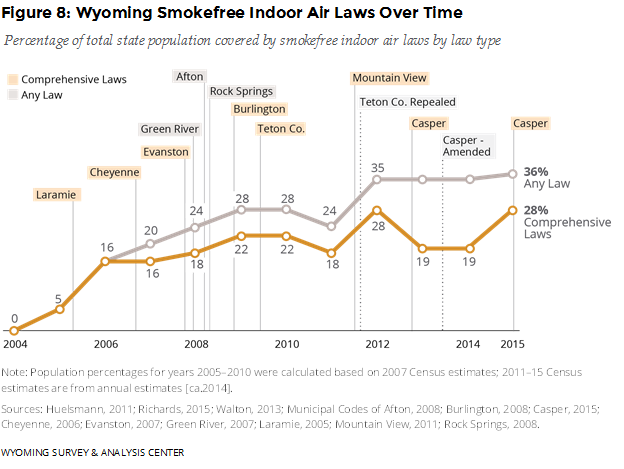Exposure to Secondhand Smoke
Smokefree Indoor Air
Smokefree indoor air policies and laws have demonstrated effectiveness in reducing youth initiation, reducing exposure to secondhand smoke, and increasing cessation of tobacco use (Guide to Community Preventive Services, 2015). Since the city of Laramie enacted Wyoming’s first smokefree indoor air law in 2005, the coverage and number of these laws in Wyoming have increased (Figure 8). Currently, six cities in Wyoming have comprehensive smokefree indoor air laws. A law in Lyman includes a clause that allows business owners to opt out by prominently displaying signs identifying the business as a smoking establishment (Lyman Municipal Code, 2011). Because WYSAC does not have data about the decisions of all individual business owners in Lyman, WYSAC does not include Lyman residents as covered by a smokefree indoor air law.
Smokefree Indoor Air Laws: Wyoming and the Nation
Wyoming does not have a statewide smokefree indoor air law. However, every one of the six states bordering Wyoming has some sort of statewide smokefree indoor air law (CDC, 2016). Five of the six bordering states have a smokefree indoor air law that covers three locations (private workplaces, restaurants, and bars; Figure 9).
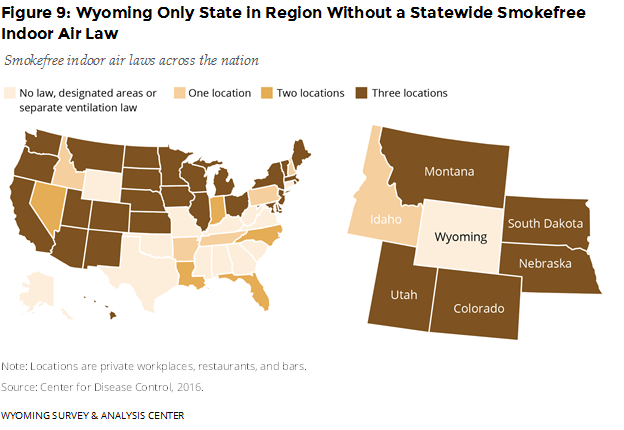
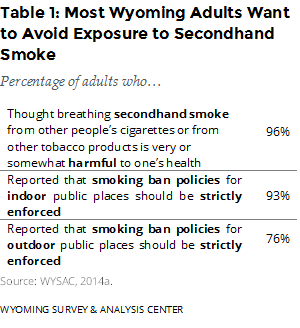 Smokefree Policies
Smokefree Policies
Voluntary smokefree policies in workplaces, restaurants, bars, and homes also provide some protection from secondhand smoke (Guide to Community Preventive Services, 2015). Wyoming adults generally believe that such policies should be strictly enforced, and they recognize the overall risk of breathing secondhand smoke (Table 1; WYSAC, 2014a).
The 2011 Wyoming Workplace Tobacco Survey documented the existence and implementation of smokefree air policies in Wyoming workplaces with more than 25 employees. Smokefree air policies are most common in the field of education/ government. Of the 640 surveyed workplaces, 24% had a policy prohibiting smoking by anyone at any time indoors; 13% had a written policy that prohibited smoking by anyone, at any time, both indoors and outdoors (Table 2; WYSAC, 2011).
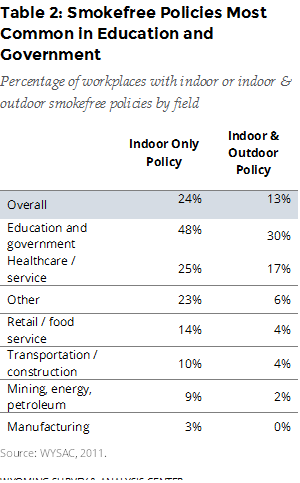 Support for smokefree indoor areas of workplaces; restaurants; and bars, casinos, or clubs has significantly increased since 2004 (Figure 10). In 2012, the majority of Wyoming adults (79%) said that smoking should never be allowed in indoor workplaces, an increase from 70% in 2004 (WYSAC, 2014a). For comparison, in 2010, 82% of U.S. adults reported that smoking should never be allowed in indoor workplaces (King, Dube, & Tynan, 2013).
Support for smokefree indoor areas of workplaces; restaurants; and bars, casinos, or clubs has significantly increased since 2004 (Figure 10). In 2012, the majority of Wyoming adults (79%) said that smoking should never be allowed in indoor workplaces, an increase from 70% in 2004 (WYSAC, 2014a). For comparison, in 2010, 82% of U.S. adults reported that smoking should never be allowed in indoor workplaces (King, Dube, & Tynan, 2013).
Support for eliminating secondhand smoke from indoor dining areas of restaurants grew from 57% of Wyoming adults in 2004 to 78% 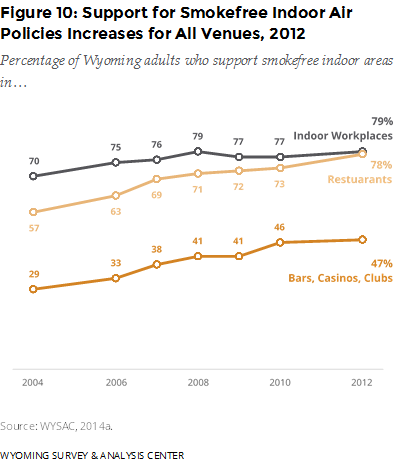 in 2012 (WYSAC, 2014a). For comparison, in 2010, 75% of U.S. adults reported that smoking should never be allowed in indoor dining areas of restaurants (King et al., 2013).
in 2012 (WYSAC, 2014a). For comparison, in 2010, 75% of U.S. adults reported that smoking should never be allowed in indoor dining areas of restaurants (King et al., 2013).
Support for eliminating secondhand smoke from indoor areas in bars, casinos, or clubs grew from 29% of Wyoming adults in 2004 to 47% in 2012 (Figure 10). For comparison, in 2010, 50% of U.S. adults reported that smoking should never be allowed in indoor areas of bars, casinos, or clubs (King et al., 2013).
In 2014, 79% of Wyoming adults reported that they would support a law making indoor workplaces smokefree, 78% would support a law making indoor areas of restaurants smokefree, 57% would support a law making indoor areas of bars smokefree, and 58% would support a law making indoor areas of casinos/clubs smokefree (WYSAC, 2014b). In 2014, 71% of Wyoming’s registered voters said they would support a comprehensive statewide smokefree indoor air law (WYSAC, 2015a).
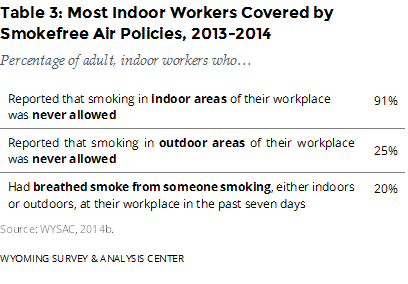 Most Wyoming adults who work primarily indoors are covered by policies prohibiting smoking in the indoor areas of their workplaces, but these policies do not completely protect Wyoming workers from secondhand smoke (Table 3). Few Wyoming adults allow smoking in their homes (Table 4; WYSAC, 2014b).
Most Wyoming adults who work primarily indoors are covered by policies prohibiting smoking in the indoor areas of their workplaces, but these policies do not completely protect Wyoming workers from secondhand smoke (Table 3). Few Wyoming adults allow smoking in their homes (Table 4; WYSAC, 2014b).
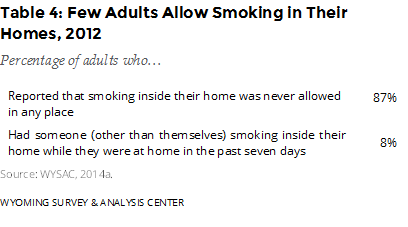 According to the Wyoming 2014 School Health Profiles Report: Trend Analysis Report (2015), schools qualify as tobacco-free when there is a policy that specifically prohibits the use of all types of tobacco (including cigarettes, smokeless tobacco, cigars, and pipes, but not necessarily ENDS) by all people (all students, faculty/staff, and visitors) at all times (including during non-school hours) and in all places (including school-sponsored events held off campus). In 2014, 50% of Wyoming schools had tobacco-free policies, a statistically significant increase from 44% in 2008.
According to the Wyoming 2014 School Health Profiles Report: Trend Analysis Report (2015), schools qualify as tobacco-free when there is a policy that specifically prohibits the use of all types of tobacco (including cigarettes, smokeless tobacco, cigars, and pipes, but not necessarily ENDS) by all people (all students, faculty/staff, and visitors) at all times (including during non-school hours) and in all places (including school-sponsored events held off campus). In 2014, 50% of Wyoming schools had tobacco-free policies, a statistically significant increase from 44% in 2008.

